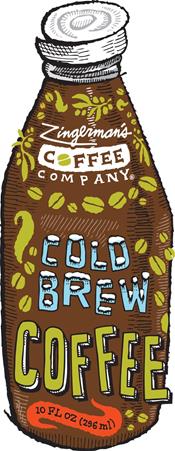These days boutique coffee shops offer about seventeen different ways to make a cup of coffee. Each of those different brewing methods will produce slightly different flavors. To get the sweetest, smoothest cup of coffee, though, your best bet is to skip the in-the-moment brewing all together and go with a bottle of cold brew.
How is cold brew different from regular “hot brew” coffee?
Sometimes people think that cold brew is hot coffee that’s been put over ice. It’s not; that’s iced coffee. To make cold brew, you start with the same ingredients as regular coffee: ground coffee beans and water. Then you steep the ground coffee in cool water—it’s never heated up. When coffee beans are heated they release acids that come across as bitter flavors. When you make cold brew, the flavor ends up being sweeter and smoother without that acidic, bitter kick. The way we make cold brew at Zingerman’s, it’s also a lot more caffeinated. A 10-ounce cup of cold brew has three times as much caffeine as a 10-ounce cup of hot coffee, because it’s made with three times as much ground coffee.
You could make cold brew coffee at home. You just need to know you’re going to want some half a day before drinking it—and get to work. The advantage to making coffee with hot water is that it’s ready to drink in a few minutes. Hot water extracts the flavor from ground coffee in moments. Extracting the same amount of flavor with cold water takes hours. Steve Mangigian, owner and roastmaster at Zingerman’s Coffee Company, recommends 16 hours of steeping for the full flavor. That means to have your cuppa ready to drink at 8 AM, you’d want to start making it the day before at 4 PM. If you’re good at planning that far ahead, to make your own cold brew you’d want to take really good coffee beans, give them a coarse grind, then let them steep overnight at room temperature. A good ratio to use is 3 ounces of coffee for 16 ounces of water. When you’re ready to drink it, strain out the grounds and dilute it with one part water to two parts cold brew.
There’s no hiding bad coffee beans in cold brew.
Have you ever noticed that sometimes a cup of coffee that tastes pretty good when it’s hot tastes pretty terrible once it’s cold? That’s classic poor quality coffee. It’s a common story: coffee, bread, pasta, and plenty of other foods taste all right when they’re hot and fresh, but as soon as they cool down to room temperature they show their true colors. Really good coffee still tastes great when cold. Test it for yourself. Try two cups of coffee side by side: brew two coffees in a row, or stop at two different coffee shops for a cup of plain black coffee. Be sure to try one made with great coffee and one with not-so-great coffee. Taste them hot. Then let them cool down, and be prepared to be wowed by the difference.
Since cold brew is never heated, there’s no hiding poor quality. You can’t skimp on the raw material. At Zingerman’s Coffee Company, we use a blend of beans carefully sourced directly from the growers in Brazil and Indonesia. Buying coffee directly like that is a little like buying your vegetables at the farmer’s market: you can build a relationship directly with the grower, and that often translates into getting the most flavorful produce. The Brazilian-Indonesian blend makes for a chocolatey, full-bodied, sweet cold brew coffee. It’s incredibly smooth, without the acidic bite you sometimes find in hot coffee.
Almost every other cold brew on the market has preservatives added or needs to be refrigerated—or both.
The exception to this rule is the cold brew from Zingerman’s Coffee Company. They’ve spent the last few years developing a process for making cold brew made with only coffee and water that’s shelf stable for up to a year at room temperature. It’s still best served chilled (though it tastes great at room temperature, too), but feel free to toss it in your car and drive around with it for a couple of days before popping it open—ideally at a picnic on the beach.

